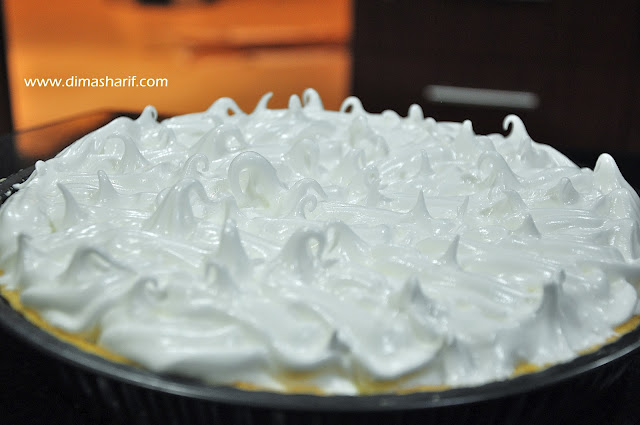 |
Egg Foams - The effects of beating eggs
Normally, physical agitation (produced by beating) destroys structure, but not for eggs. Beating eggs actually creates structure. For example if you place an egg white in a bowl and beat it with a whisk, in a few minutes you will achieve a glossy foamy texture that clings to the sides of the bowl when turned upside down! This same structure becomes firm and brittle when cooked, holding its own shape.
This foaming ability that the eggs have is basically, the ability of the egg whites to cling to air and make it an integral part of the ingredients making up the dish. Therefore, through beating the egg white, we are incorporating air, which is encased by the egg whites. This starts the build up of a foam. The more this foam is beaten, the more volume it acquires as more air is incorporated... The chemical and physical make up of the egg whites (its proteins), make it a less runny liquid which allows it to hold its form when foamed. Which is why the egg foam survives - as foam - longer than that created with other liquids. That's the reason why when whipped into stiff peaks, egg whites can hold perfect shape, allowing us to pipe it into detailed decorations, such as when making meringue moments or in the case of royal icing.
The addition of sugar to egg whites, adds density to the foam, making it more stable and thicker. It is usually added to egg whites after they had started foaming. But in some cases it can be added to the egg whites on the outset, which is done when a very firm, and dense foam is required (this is the most used method for commercial production of meringue). This is especially true when the meringue is going to be piped, or used in the creation of details.
Stages of beating egg whites
Beating egg whites results in foam (as in picture 1 above), once the foam is achieved continuing to beat will result in the formation of soft peaks (as in picture 2 above), these are peaks that curl up when you remove the whisk. Usually sugar is added at this stage. Then, further beating will result in the formation of stiff peaks (as in picture 3 above). Stiff peaks remain firm and straight once the whisk is removed. At this stage the foam should keep shape, and cling to the sides of the bowl, when flipped upside down.
V
V
ฟองโฟมไข่ ผลของการตีไข่
โดยปกติ การเขย่าทางกายภาพ ( เกิดขึ้นด้วยการตี )จะทำลายโครงสร้าง, แต่ไม่ใช่สำหรับไข่ การตีไข่จริงๆแล้วเป็นการสร้างโครงสร้าง ตัวอย่างเช่นคุณใส่ไข่ขาวลงในชามและตีด้วยที่ตีไข่ ในไม่กี่นาทีคุณก็จะได้เนื้อโฟมเป็นเงามันวาวและจะยึดกับด้านข้างของชามเมื่อคว่ำชามบนลงล่าง โครงสร้างเหมือนกันเช่นนี้จะมั่นคงและเปราะบางเมื่ออยู่ในขั้นตอนการทำขนม, รักษารูปทรงของตัวเองเอาไว้
ความสามารถในการเป็นฟองที่ไข่มีเป็นสิ่งธรรมดา ความสามารถของไข่ขาวที่กักเอาฟองอากาศไว้ทำให้เป็นส่วนสำคัญของส่วนผสมในการทำเมนูขนมต่างๆ อย่างไรก็ตาม ช่วงที่ตีไข่ขาว เรารวมเอาอากาศเข้าไป ซึ่งจะถูกห่อหุ้มไว้โดยไข่ขาว สิ่งนี้คือการเริ่มสร้างให้เกิดฟอง ยิ่งฟองโฟมนี้ถูกตีมากเท่าไหร่ ก็ยิ่งทำให้เกิดปริมาตรมากขึ้นเท่านั้นเช่นเดียวกับยิ่งมีอากาศถูกให้รวมเข้าไปมากขึ้น จากทั้งทางเคมีและทางกายภาพที่เกิดขึ้นกับไข่ข่าว ( โปรตีนของไข่ขาว ) จะทำให้ของเหลวเกิดการไหลน้อยลงซึ่งจะทำให้ไข่ขาวรักษารูปทรงเมื่อเกิดเป็นฟองโฟมเอาไว้ได้ นี่คือการที่ทำไมฟองโฟมของไข่จึงอยู่ได้ ในรูปของโฟม- อยู่ได้นานกว่าการสร้างฟองโฟมจากของเหลวชนิดอื่นๆ นั่นคือเหตุผลที่ว่าเมื่อเราตีไข่จนตั้งยอดแข็ง ไข่ขาวจะคงรูปทรงไว้ได้อย่างสมบูรณ์ ทำให้เราสามารถที่จะบีบออกจากหัวพิมพ์ให้มีรายละเอียดสำหรับการตกแต่ง เช่น ช่วงการทำเมอแรงค์ หรือ กรณีการทำโรยอลไอซ์ซิ่ง
การเติมน้ำตาลเข้าไปในไข่ขาว จะเป็นการเพิ่มความแน่นของโฟม จะทำให้ไข่ขาวมั่นคงมากขึ้นและหนาแน่นมากขึ้น โดยปกติแล้วจะใส่น้ำตาลเข้าไปในไข่ขาวหลังจากที่เริ่มเกิดฟองโฟม แต่ในบางกรณีน้ำตาลจะสามารถถูกใส่เข้าไปในไข่ขาวในตอนเริ่มต้นเลย ซึ่งจะทำอย่างนี้เมื่อต้องการได้ฟองไข่ขาวที่มั่นคงและหนาแน่นมากๆ ( วิธีการนี้เป็นวิธีที่ถูกใช้มากที่สุดสำหรับการผลิตเมอแรงค์ในทางการค้า ) สิ่งนี้คือสิ่งเฉพาะเมื่อเมอแรงค์จะต้องการถูกบีบออกจากหัวพิมพ์หรือถูกใช้ในการสร้างรายละเอียด
ขั้นต่างๆของการตีไข่ขาว
การตีไข่ขาวเป็นผลให้เกิดฟองโฟมอย่างในรูปที่ 1 เมื่อได้ฟองโฟมแล้วตีต่อไปจนกระทั่งจับตัวตั้งยอดอ่อน ดังรูปที่ 2, การตั้งยอดอ่อนจะเห็นยอดโค้งงอลงเมื่อยกที่ตีไข่ออกมา โดยปกติแล้วน้ำตาลจะถูกใส่ที่ขั้นตอนนี้ และแล้ว ก็จะตีไข่ขาวต่อไปจนกระทั่งจับตัวตั้งยอดแข็ง ดังในรูปที่ 3 ยอดแข็งยังคงมั่นคงและตั้งตรงเมื่อยกที่ตีไข่ออกมา ที่ขั้นนี้ฟองโฟมจะรักษารูปทรงเอาไว้และยึดกับด้านข้างของชามเมื่อคว่ำชามบนลงล่าง
แก้ไขเมื่อ 21 เม.ย. 55 17:56:25
| จากคุณ |
:
Imperio  
|
| เขียนเมื่อ |
:
21 เม.ย. 55 17:53:22
|
|
|
|
 |





























